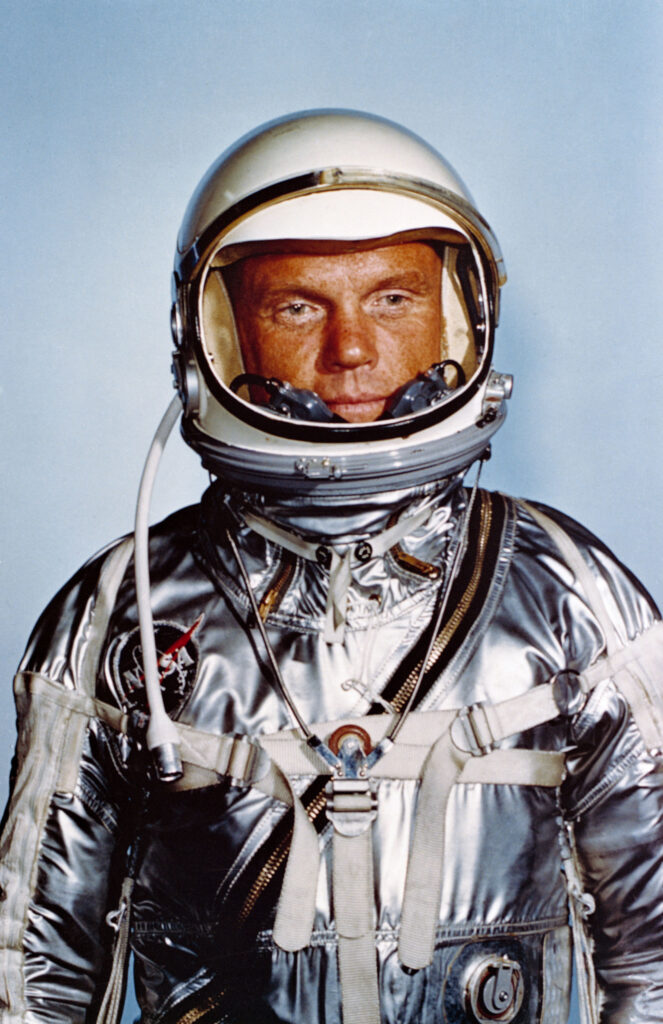The first American to orbit the Earth, 37 years later, he became the oldest person to enter outer space.
John Herschel Glenn, Jr. was born July 18, 1921, in Cambridge, Ohio, but considers New Concord, Ohio his permanent home. The son of a plumbing contractor, he attended primary and high schools in New Concord then received a Bachelor of Science degree from Muskingum College there.
Glenn entered the Naval Aviation Cadet Program in March 1942, graduating a year later with a commission in the Marine Corps. After advanced training, he joined Marine Fighter Squadron 155 and spent a year flying F4U fighters in the Marshall Islands, including 59 combat missions against the Japanese. After World War II, he was a member of Fighter Squadron 218 on North China patrol and was also stationed in Guam.
From June 1948 to December 1950 John Glenn was an instructor in advanced flight training at Corpus Christi, Texas. He then attended Amphibious Warfare School at Quantico, Virginia. In the Korean War, he flew 63 combat missions with Marine Fighter Squadron 311 and 27 while an exchange pilot with the Air Force in F-86 Sabrejets. In the last nine days of fighting in Korea, he downed three enemy jets. After the war, Glenn attended Test Pilot School at the Naval Air Test Center, Patuxent River, Maryland. He was next assigned to the Fighter Design Branch of the Navy Bureau of Aeronautics in Washington from November 1956 to April 1959, during which time he also attended the University of Maryland.
In April 1959, Glenn was selected as one of the original seven astronauts for Project Mercury and assigned to the National Aeronautics and Space Administration (NASA) Space Task Group at Langley Research Center in Hampton, Virginia. The Group was moved to Houston and became part of NASA’s Manned Spacecraft Center in 1962.
As NASA’s third manned mission, John Glenn and his Friendship 7 spacecraft were launched from Cape Canaveral, now the Kennedy Space Center (KSC), Florida on February 20, 1962. He completed three orbits of the Earth, reaching a maximum altitude of approximately 162 statute miles and an orbital velocity of approximately 17,500 miles per hour. The Mercury spacecraft landed safely in the Atlantic Ocean, 800 miles southeast of Cape Canaveral after a flight of four hours and 55 minutes. As the first American astronaut to orbit the Earth, John Glenn was the nation’s newest hero.
Glenn resigned from the Manned Spacecraft Center on January 16, 1964. He retired from the Marine Corps with the rank of colonel on January 1, 1965. Glenn was a business executive from 1965 until his election to the United States Senate as a Democrat from Ohio in November 1974. John Glenn retired from the U.S. Senate in January 1999 after serving four terms.
At age 77, John Glenn became the oldest person to travel to outer space when he blasted off from KSC aboard STS-95 Discovery on October 29, 1998. During the mission, the shuttle crew supported a variety of research payloads, including the deployment of the Spartan solar-observing spacecraft, the Hubble Space Telescope Orbital Systems Test Platform, while also conducting investigations on space flight and the aging process. The mission ended with a landing at KSC on November 7, 1998 after 134 Earth orbits, having traveling 3.6 million miles in 213 hours and 44 minutes. In his two flights, Colonel Glenn logged over 218 hours in space. He holds the record for the longest time between space flights at 38 years and two months.
John Glenn earned the Distinguished Flying Cross on six occasions and holds the Air Medal with 18 Clusters for his service during World War II and Korea. He also holds the Navy Unit Commendation for service in Korea, the Asiatic-Pacific Campaign Medal, the American Campaign Medal, the World War II Victory Medal, the China Service Medal, the National Defense Service Medal, the Korean Service Medal, the United Nations Service Medal, the Korean Presidential Unit Citation, the Navy’s Astronaut Wings, the Marine Corps’ Astronaut Medal, and the NASA Distinguished Service Medal, In 1978 he was one of the six original recipients of the Congressional Space Medal of Honor, for his Friendship 7 mission.

